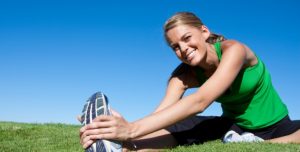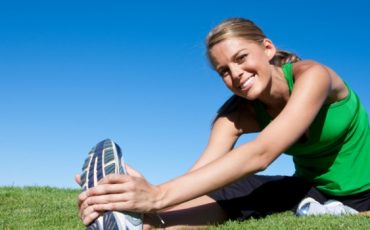Avoid coming to a dead stop when you’re done with your walking workout. Just as you had to allow your heart, mind, and muscles to get used to the idea that you were picking up the pace, you have to give them the same chance to realize you’re slowing down. A cool-down is exactly what it says: cooling down your body after heating it up during a workout. Don’t just jump into your car or into the shower. Let your system cool off and return gradually to its steady state. Repeat what you did in the warm-up. Walk slowly for about 5 minutes (or more if the workout was long and very intense), rolling your shoulders and shaking out your hands. Now you’re ready to stretch deeply.
No fitness program can be well rounded without exercises for flexibility. Flexibility exercises should be the unquestioned finish for every walk, with additional stretching on rest days or as cross-training. Think also about doing casual or impromptu stretches, such as a back stretch while sitting at your desk or a calf stretch while waiting in the grocery checkout line.
 If you don’t stretch, walking, like any other activity, will slowly tighten the muscles in your buttocks (gluteal group), the backs of your thighs (hamstrings), and your calves (gastrocnemius). It’s important to follow the flexibility exercises in this article to continue walking injury free and comfortably.
If you don’t stretch, walking, like any other activity, will slowly tighten the muscles in your buttocks (gluteal group), the backs of your thighs (hamstrings), and your calves (gastrocnemius). It’s important to follow the flexibility exercises in this article to continue walking injury free and comfortably.
Muscles shorten as they tire during exercise. Stretching after a workout will return them to their preworkout length and perhaps teach them to be a little more flexible. Working out without stretching starts the snowball effect: You don’t stretch because you’re tight, but the less you stretch, the tighter you get! A tight muscle isn’t only uncomfortable, it often signals weakness, and tightness and weakness set you up for strains and other injuries. After a workout, your muscles are pliable and ready to stretch without getting hurt. Follow three easy rules when you stretch:
- Stretch until you feel tension and a mild discomfort, but not pain. Hold the stretch at this point and breathe deeply.
- Don’t bounce. Bouncing causes the muscles to protect themselves from overstretching by tightening. Yes, you’ll actually tighten your muscles if you bounce.
- Hold each stretch for 10 to 30 seconds to let the muscle relax. Continue to breathe deeply, and as the muscle releases, you’ll be able to stretch a bit farther.
If you follow the popular media, perhaps you’ve heard about the 2004 journal article from researchers who said they found no proof that stretching reduced injuries. That research was a thorough, well-done review of past studies on stretching to assess that relationship. It concluded that stretching was not
significantly associated with a reduction in injuries. However, it also said (and this is the part often left out) that there was not enough evidence to endorse or recommend discontinuing stretching exercises by active people before or after exercise, and it urgently called for more well-conducted studies to determine stretching’s proper role in sports and exercise. So, the bottom line is, don’t stop. Adding a few stretches won’t hurt, and the review found that stretches did seem to show increased flexibility if held long enough. Stretching just may provide preventive medicine.
The following stretches will help you loosen up before and after your walks.
Hamstrings
Stand about 2 feet away from a bench or raised surface. Place your right leg on the bench, allowing your left leg to bend slightly. With your hands resting on your right thigh, lean forward, bending at the hips and keeping your spine extended without hunching. Reach forward with your chest and keep your chin from dropping to your chest. Repeat on the other side.
Hips, Back, and Buttocks
Sit on the ground with your legs extended forward. Bend your left leg and cross your left foot over your right knee, placing your left foot on the ground on the outside of your straight right knee or lower leg. Rest on your left hand beside and behind you for support. Wrap your right arm around your left knee and gently pull the knee toward you as you twist your head and torso in the direction of your left arm. Repeat on the opposite side.
Inner Thighs
Sit on the ground with your knees bent and the soles of your feet together. Grasp your ankles and lean forward, keeping your back straight as you stretch and trying to relax your knees downward. You can also sit with your back to a wall to help you into this stretch.
Thighs and Hip Flexors
Stand with your right hand against a flat surface (such as a wall or tree) for balance and support. Bend your left leg behind you, grasping the ankle with your left hand. Bend your right knee slightly to help keep you from swaying your back. Push your left foot back- ward into your hand while keeping the knee pointed toward the ground and your hips pressed forward. Repeat on the opposite side. Avoid this stretch if you have chronic knee pain. Also, avoid pulling your foot toward your buttocks, as this will place excessive strain on your knees.
Sides of Legs
Stand next to a wall about an arm’s length away. Using your arm to support you, cross the leg farthest from the wall over the front of the leg nearest the wall. Push your hip toward the wall, keeping the leg nearest the wall straight while allowing the crossed leg to bend. Allow your supporting arm to bend as your hip reaches toward the wall. Repeat on the opposite side. Avoid turning or twisting your body toward or away from the wall.
Shins
Place the top of the foot on the ground behind you and press your ankle toward the ground, allowing your knee to bend as you stretch. Repeat on the opposite side. This can also be done while sitting in a chair to achieve additional stretch through the front of your lower leg.
Calves
Face a wall with one foot close to the wall and one about two feet behind you. The knee of the back leg should remain straight with the heel on the ground. If you cannot maintain that position, bring the foot closer to the wall. The front leg should be bent at the knee in a lunge like position. Place your hands against the wall, and then bend your arms as you lean toward the wall, keeping your back straight and abdominals tight. To achieve a calf stretch, keep the rear heel on the floor. Repeat on opposite side. To stretch a different part of the calf, repeat above, but move the rear foot in slightly and bend the rear knee while still keeping the heel on the ground.
Back
Stand about 18 inches away from a wall or flat surface with your feet parallel to it. Turn toward the wall and place both hands on it at about chest height. Gently continue turning toward the wall, using your fingers to crawl along the wall, reaching behind you. Repeat on the opposite side.
Low Back
Lie flat on your back. Bend your knees and bring them toward your chest while grasping behind your thighs. Pull your knees toward your shoulders until your hips come off the ground. After holding the stretch, extend your legs slowly, one at a time. You can also do this stretch with one knee at a time pulled toward your chest. If you have back problems, check with your doctor first.
Chest
Stand with your back to a wall. Reach back and place one of your palms on the wall with your wrist facing out and your arm outstretched at shoulder height. Gently turn your head and chest away from the wall as far as you can. Repeat on the opposite side.

Leave a Reply